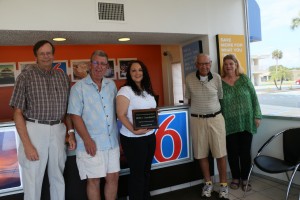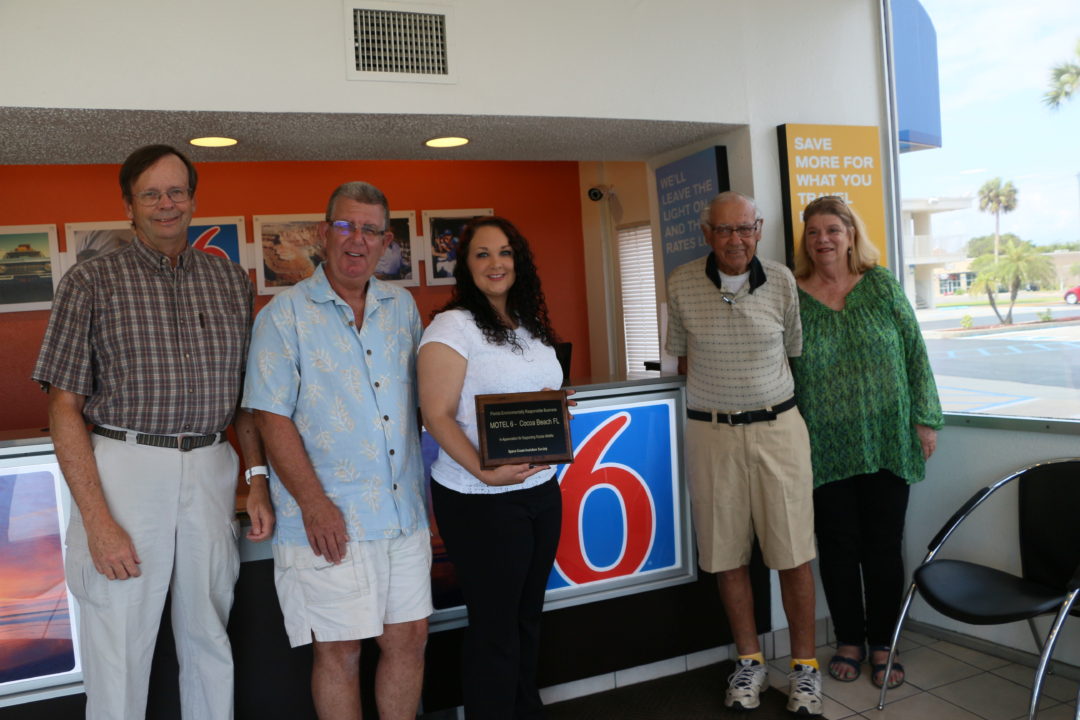
Space Coast Audubon gives award to Motel 6 Cocoa Beach for their help with the baby Least Terns. April 20, 2016
Left to Right: Mark Wallace (President), Jeff Lamothe (Incoming President), Kristen Vadini (General Manager Motel 6, Cocoa Beach FL), Howard Mansfield (long time birder and builder of the “chick elevator”, Gloria LeBlanc
Nesting at Motel 6 in Cocoa Beach – scroll down for May 6th meeting
2016 – First arrival of Least Terns to Motel 6 was Thursday, April 20.
The Least Tern is the smallest North American member of the gull and tern family measuring 8.7-9.4 inches long. It is a slender, streamlined bird with a white breast and belly. Weight is only 1.4-1.8 oz. It has a gray back and a black cap on its head. Its wingspan is 20 inches and wings are long and narrow. It has a forked tail and a straight, pointed beak that is usually a deep yellow color. Least Terns feed on small fish (anchovies and smelt are favorites) that they catch near the surface of the water.
Least Terns winter in Central America, Caribbean and all the way south to Brazil. They nest from Florida to Maine. Thus, they are migratory birds who travel long distances.
Nesting and Breeding Behavior: The Least Tern arrives at its breeding ground in late April. Courtship typically takes place removed from the nesting site, usually on exposed tidal flat or beach. Only after courtship has confirmed mate selection does nesting begin by mid-May. It is usually complete by mid-June. Typically the clutch is two eggs. Both male and female incubate the eggs for about 3 weeks. Both parents tend their young. When the chicks are 3 days old, they are brooded less frequently. Young birds fly at age 4 weeks. The bulk of Least Terns have left the breeding grounds by the end of August and return to where they winter.
White Gravel Flat Roofs: The first instance of roof-nesting was in 1957 on top of the city auditorium in Pensacola. They prefer flat roofs with gravel to decrease drowning of the chicks when it rains. Now 80% of Least Tern nesting sites in Florida are on white gravel flat roofs. These roofs typically have a life span of 25 years. As they age many of the gravel roofs are being replaced with a smooth surface displacing the Least Tern.
Endangered/Threatened: In 1870’s it is said that 1,000 Least Terns were killed daily for feathers for hats. Between 1940 and mid-1970’s the Least Tern population declined 80% due to lack of habitat. In 1974 there were 59 colonies of nesting Least Terns in the entire state of Florida. In Florida beachfront development has eliminated most suitable nesting habitat. (1996). Today Florida has the Least Tern listed as Threatened.
Local nesting sites: Motel 6 (Cocoa Beach), Cape Canaveral Hospital, Winn Dixie (Merritt Island), US Post Office (Titusville). There may be more.
At Motel 6: The babies that are 24 hours old or so are a pale yellow color. By 3 days they are speckled. They gradually acquire feathers to replace their “fluff”. Babies fall off the roof. If you see a baby, it’s best chance of survival is to return it to the roof for parents to feed. Call or take baby to Front Desk.
May 6, 2016
Training on May 6th from 10am – 2pm at the Indian Harbour Beach Recreation Center and Winn Dixie. Please RSVP to [email protected] and [email protected] . The Rec Center is in Gleason Park on the corner of S. Patrick Drive and Yacht Club Blvd. The address is 1233 Yacht Club Blvd. Indian Harbour Beach, FL 32937. The indoor portion of the training will be held from 10am – 12pm in the Rec Center meeting room. This will involve presentations on data collection and FSD data entry practice. Please bring a laptop or tablet if you have one so you can practice entering data.
After that, lunch will be on your own and then you will be meeting at 1 pm at the Winn Dixie at 961 E Eau Gallie Blvd, Melbourne, FL 32937, which is only about 5 minutes away. Click this link for directions. At Winn Dixie, you will practice flush counts of least terns from the parking lot and how to record the data on the data sheets. Bring binoculars for the flush counts. Organized by
Florida Fish and Wildlife Conservation Commission

